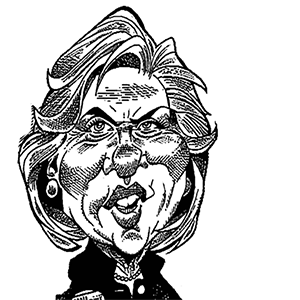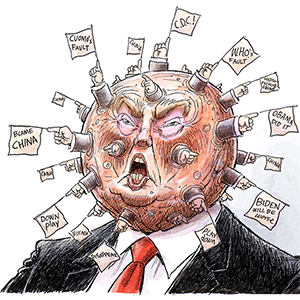Commentary: Your state better be ready to protect workers under Trump
Published in Op Eds
In the late 1970s, when Jimmy Carter was president, the Occupational Safety and Health Administration (OSHA) was less than a decade old and still developing basic workplace safety rules. As unimaginable as it is now, workers did not have the right to know the names and toxic properties of the chemicals to which they were exposed, or to be trained on protective measures. OSHA had proposed a “right to know” standard, but it was halted by the incoming administration of President Ronald Reagan.
We are at a similar moment now: We can expect public health regulations to be weakened or stopped by the incoming Donald Trump administration. In response, states and localities need to step in and ensure better protections for their residents.
States and localities can be leaders in public health because in our federal system, most public health powers reside in the states. No matter what Robert F. Kennedy Jr., Trump’s choice to lead the Department of Health and Human Services, advocates for federal government actions, key policies on pediatric vaccinations, including school attendance requirements, are set by states and localities.
History is instructive. With the end of the federal right-to-know effort in the 1970s, workplace safety advocates began focusing on state and local laws. In a famous example, a workers’ rights coalition in Philadelphia sensationalized the need for right-to-know rules by opening an unmarked pressurized canister at a public hearing of the City Council; panic-stricken council members demanded to know “What’s in this stuff?” The activists had made their point, and the council enacted what’s considered the nation’s first civic right-to-know ordinance.
State and local health departments can make heroic achievements, but sometimes fail to do so. Early in the influenza pandemic of 1918, the Philadelphia health commissioner, ignoring warnings from medical experts, refused to cancel a major parade to raise money for war bonds. Within three days, all 31 of Philadelphia’s hospitals were full; within six weeks, more than 12,000 residents were dead. By contrast, the St. Louis health department did what we would now call “flattening the curve” — closing schools, movie theaters and pool halls, and banning all public gatherings, over the objections of business owners. The peak mortality rate in St. Louis was a fraction of that of Philadelphia.
Changes in state and local policies can even drive improvements in federal policies. Businesses generally want uniform national marketing and labeling policies. Faced with a range of different right-to-know requirements around the country, many industries recognized they would be better off with one national standard. By 1983, President Reagan’s OSHA issued the Hazard Communication Standard, which labor and public health activists had been demanding.
State laws reducing consumer exposures to toxic chemicals have also been effective in shaping national environmental policies. The original Toxic Substances Control Act of 1976 helped eliminate or reduce the use of some particularly dangerous chemicals — low-hanging regulatory fruit like PCBs and dioxin — but was generally toothless when it came to many other chemicals, particularly ones that disrupt the endocrine system.
Parents who wanted children’s toys and water bottles to be free of these chemicals pushed numerous states to pass laws banning or limiting the presence of the substances in certain products. The challenge of meeting inconsistent laws in multiple states, and the fear of a greater proliferation of these laws, brought the chemical industry to the table to negotiate strengthened legislation with environmental activists in 2017.
Unfortunately, politics and ideology now drive much local public health decision-making, with dangerous effects on health and disease prevention. During the COVID pandemic, there was significant variation in the strength and timing of requirements meant to limit the spread of the virus.
Not surprisingly, disagreements over public health protection continue. North Carolina and New York’s Nassau County recently passed laws banning the wearing of masks, including N95 respirators, in public. It seems likely that some states or localities will roll back school vaccination requirements, which will probably be followed by outbreaks of the serious and sometimes fatal pediatric infectious diseases that were common before mandatory vaccination policies.
States also play a major role in enforcing national environmental requirements. If the Environmental Protection Agency is handcuffed by the Trump administration, states can and should step into the enforcement breach.
Likewise, state governments, especially those with their state OSHA programs, can issue their own workplace standards. This dynamic is already underway around exposures to extreme heat. This summer, OSHA proposed a heat standard, requiring employers to take steps to prevent heat-related illness, but these reforms are likely to be stopped by the new administration. Not wanting to wait for the slow OSHA standard-setting process to finish, local and state governments — including California, Maryland, Colorado, Oregon, Nevada and Washington — have issued their own heat standards.
But just as some states are enacting more protections, others are fighting such efforts. For example, two Texas cities — Dallas and Austin — passed ordinances requiring employers to give workers a 10-minute break every four hours in periods of extreme heat. But the Texas state legislature last year passed legislation forbidding municipalities from requiring worker protections stronger than state regulations. The Florida legislature did the same in July.
The challenge for the public health community in the coming four years is to strengthen public health protections at the state and local level, promoting advances that prevent disease and save lives. We must also document our successes and failures, objectively determining the impact of protections (or the lack of protections) in states and localities across the nation.
At this critical juncture, we need to ask: Are we going to be the Philadelphia of 1918, or the St. Louis?
_____
This column does not necessarily reflect the opinion of the editorial board or Bloomberg LP and its owners.
David Michaels is a professor at the Milken Institute School of Public Health at George Washington University. He served as assistant secretary of labor for the Occupational Safety and Health Administration from 2009 to 2017.
_____
©2024 Bloomberg L.P. Visit bloomberg.com/opinion. Distributed by Tribune Content Agency, LLC.




























































Comments